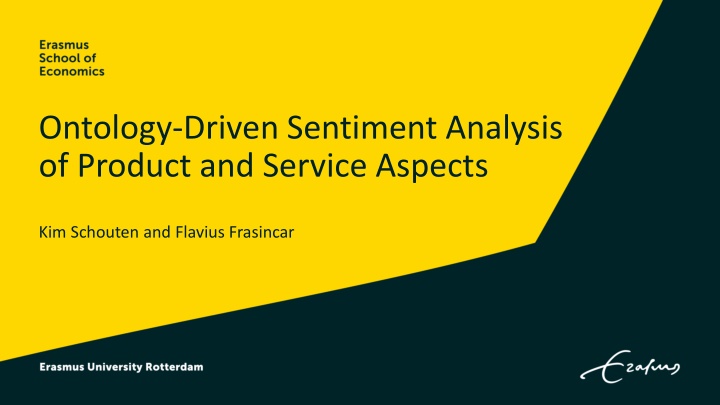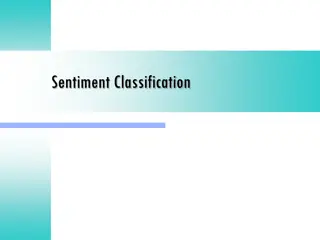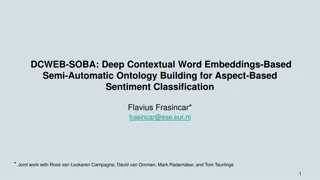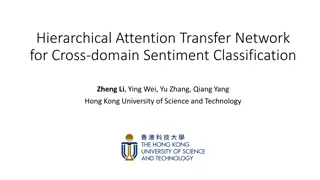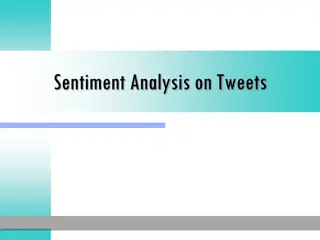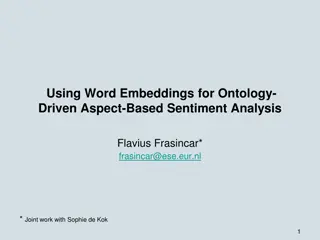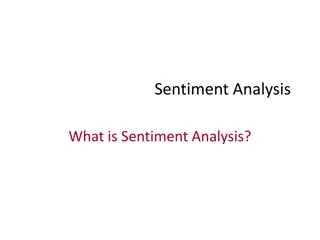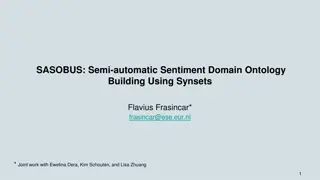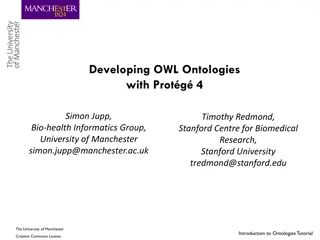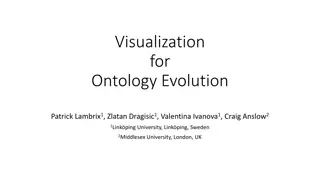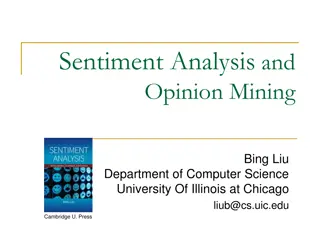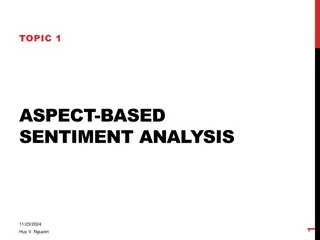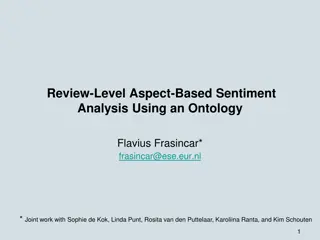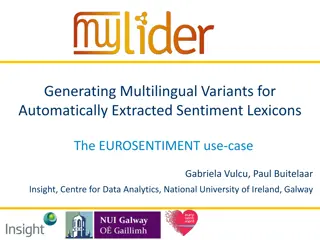Ontology-Driven Sentiment Analysis for Product and Service Aspects
Sentiment analysis through ontology to determine positive, negative, or neutral sentiments for different aspects of entities. Utilizing ontology for sentiment inference yields explainable results but requires a comprehensive ontology. The purpose is to link lexicalizations to aspect and sentiment concepts, enhancing high-level aspect annotations
Download Presentation

Please find below an Image/Link to download the presentation.
The content on the website is provided AS IS for your information and personal use only. It may not be sold, licensed, or shared on other websites without obtaining consent from the author.If you encounter any issues during the download, it is possible that the publisher has removed the file from their server.
You are allowed to download the files provided on this website for personal or commercial use, subject to the condition that they are used lawfully. All files are the property of their respective owners.
The content on the website is provided AS IS for your information and personal use only. It may not be sold, licensed, or shared on other websites without obtaining consent from the author.
E N D
Presentation Transcript
Ontology-Driven Sentiment Analysis of Product and Service Aspects Kim Schouten and Flavius Frasincar
Problem statement What sentiment is expressed about which aspect of a given entity? Usually only look at polarity: is it positive, neutral, or negative? SemEval-2015/2016 ABSA task data Reviews are split in sentences Sentences are annotated with aspects For each aspect, determine positive/negative/neutral Can we do this task using an ontology, and not just as a glorified sentiment lexicon?
Role of ontology Previous work used ontology to get additional features to improve a classifier Hard to interpret results What if we used just the ontology to infer sentiment? Results are 100% explainable Ontology has to be large enough (which it isn t) To cover for the small ontology size, we also train a bag-of-words classifier Used when ontology does not provide conclusive evidence No sentiment words at all Both positive and negative words
Purpose of ontology Sentiment lexicon Aspect and sentiment concepts have lexicalizations Link classes to words in text High-level aspect concepts have an aspect annotation Link classes to aspect category annotations in data set Sentiment words that are always positive are subclasses of the Positive class Same for Negative, no Neutral class. Sentiment words that have the same sentiment value, regardless of aspect are called type-1 sentiment words in the paper.
Data Snippet <sentence id="1032695:1"> <text>Everything is always cooked to perfection , the service is excellent , the decor cool and understated .</text> <Opinions> <Opinion target="NULL" category="FOOD#QUALITY" polarity="positive" from="0" to="0"/> <Opinion target="service" category="SERVICE#GENERAL" polarity="positive" from="47" to="54"/> <Opinion target="decor" category="AMBIENCE#GENERAL" polarity="positive" from="73" to="78"/> </Opinions> </sentence>
Purpose of ontology Sentiment lexicon Sentiment scope Some sentiment words are only ever used for a single aspect category These classes have this aspect class as an extra superclass Sentiment word will not be used to determine sentiment for other aspect categories For example: noisy implies the ambience aspect in the restaurant domain If the sentence also has the food aspect to compute sentiment for, noisy will be ignored In the paper, these are called type-2 sentiment words
Purpose of ontology Sentiment lexicon Sentiment scope Context-dependent sentiment The same sentiment word can have a different polarity for different aspects For such a high price, the quality is indeed high, as expected. This is modeled in the ontology using class axioms and referred to as type-3 Quality and High SubclassOf Positive Price and High SubclassOf Negative Creating a subclass of both aspect and sentiment class will trigger the axiom Reasoner will infer the right sentiment class
Sentiment classification The ontology (Ont) method uses a very simple mechanism to compute sentiment For each aspect, get all sentiment concepts in the sentence For each sentiment concept, check type If type-1: save superclasses in set If type-2: save superclasses only when aspect matches If type-3: for each directly related word that is the lexicalization of an aspect class; make a new subclass with both aspect and sentiment class as superclasses; save superclasses of this new class In case a negation is found then flip the sentiment Negator word in preceding 3 words or a neg relation Set of superclasses hopefully includes the Positive or Negative class
Sentiment classification If set contains only Positive -> predict positive If set contains only Negative -> predict negative If set contains both or none, the ontology method cannot do much We experimented with counting Positiveand Negative and picking the highest, but that did not improve performance. In case the method is inconclusive we can do two things: Predict majority class (Positive) (Ont method in paper) Use a bag-of-words model to predict sentiment (Ont+BoW method in paper)
The bag-of-words model Simple model using as features: The presence of words in the whole review The aspect category of the current aspect The sentiment value of the sentence as computed by the CoreNLP sentiment module Classifier is the standard Weka SVM model with RBF kernel and optimized hyperparameters
The alternative bag-of-words model (BoW+Ont) Basic bag-of-words model augmented with ontology features Use ontology method to find the classes for a given aspect If it only contains Positive, add Positive to the feature set In this way it has the same information as the two-stage Ont+Bow method
Sentiment distribution (2016 data set) % of aspects in data 10.0% 20.0% 30.0% 40.0% 50.0% 60.0% 70.0% 80.0% 0.0% negative Sentiment values neutral Training positive Test
Results SemEval-2015 data Out-of-sample accuracy In-sample accuracy 10-fold cv accuracy 10-fold cv st.dev. Ont 63.3% 79.4% 79.3% 0.0508 BoW 80.0% 91.1% 81.9% 0.0510 Ont+BoW 82.5% 89.9% 84.2% 0.0444 BoW+Ont 81.5% 91.7% 83.9% 0.0453 All averages are statistically significant, except Ont+BoW vs. BoW+Ont
Results SemEval-2016 data Out-of-sample accuracy In-sample accuracy 10-fold cv accuracy 10-fold cv st.dev. Ont 76.1% 73.9% 74.2% 0.0527 BoW 82.0% 90.0% 81.9% 0.0332 Ont+BoW 86.0% 89.3% 84.3% 0.0319 BoW+Ont 85.7% 90.4% 83.7% 0.0370 All averages are statistically significant
Data size sensitivity analysis (SemEval-2015 data) Keep the test set the same Use only n% of available training data Set n to 10:100 with step size 10 Accuracy 50% 55% 60% 65% 70% 75% 80% 85% 90% 100% 90% Ont 80% Proportion of training data used 70% BoW 60% 50% Ont+BoW 40% 30% 20% BoW+Ont 10%
Data size sensitivity analysis (SemEval-2016 data) Keep the test set the same Use only n% of available training data Set n to 10:100 with step size 10 Accuracy 70% 72% 74% 76% 78% 80% 82% 84% 86% 88% 90% 100% 90% Ont 80% Proportion of training data used 70% BoW 60% 50% Ont+BoW 40% 30% 20% BoW+Ont 10%
Performance of Ont and BoW per scenario Ontology method is only used when it finds just Positive or just Negative Bag-of-words model is only used in the remaining cases Measure performance for each of the scenarios SemEval-2016 data Bag-of-words accuracy size Ontology accuracy Found only Positive 42.7% 88.1% 83.7% Found only Negative 9.8% 94.0% 85.5% Found both 4.3% 47.2% 52.8% Found none 43.2% 33.4% 77.3%
Conclusions & Future Work
Conclusions Ontology method and bag-of-words method complement each other Good hybrid performance Performance of pure ontology method is low due to lack of coverage However, when applicable Gives good performance Explainable results No training data necessary Of course good domain ontologies do not appear instantly either
Future Work Automate ontology population We currently have a semi-automatic approach that provides suggestions for ontology population Include multi-word sentiment expressions The food here is out of this world. Investigate best way to combine sentiment and distance information Currently just one step in dependency graph, but not really investigated Improve speed The Jena library rebuilds the full inference model every time a class is added Solved a bit by caching, but not pretty
Questions? https://github.com/KSchouten/Heracles
